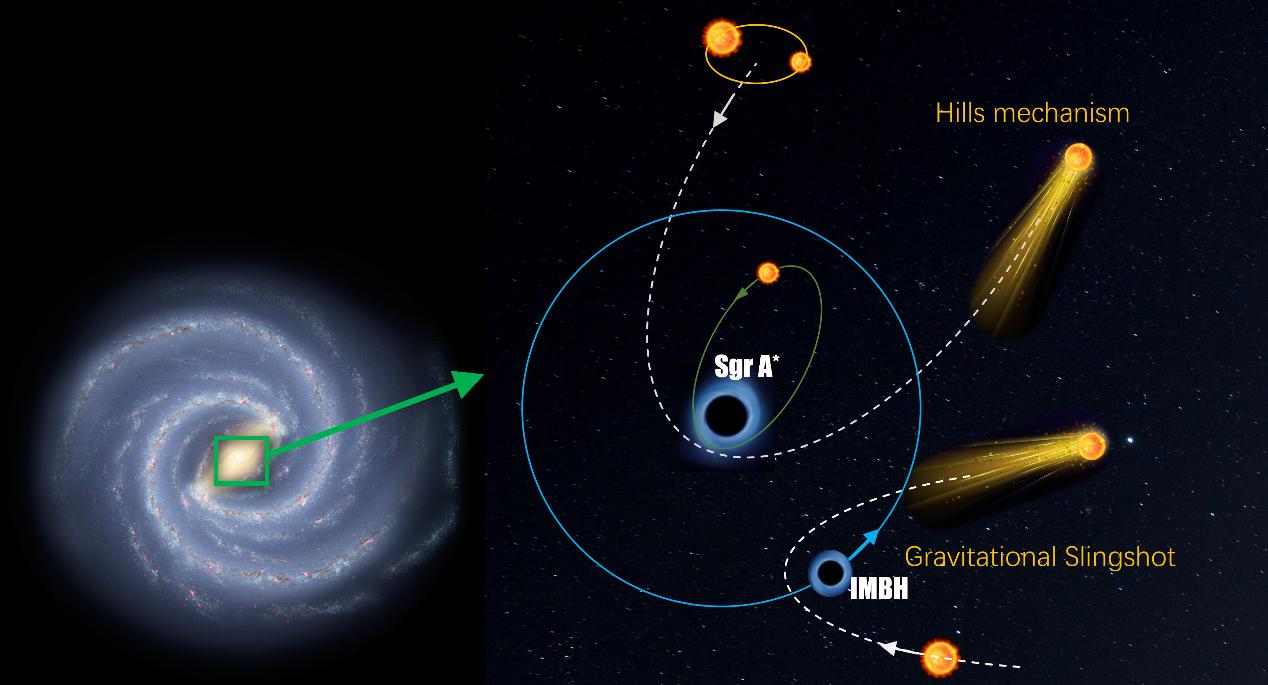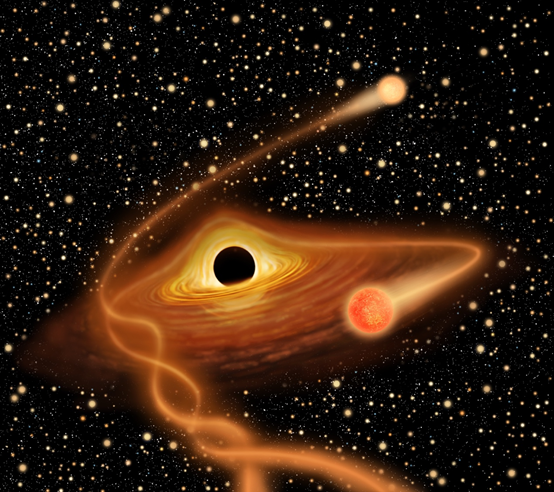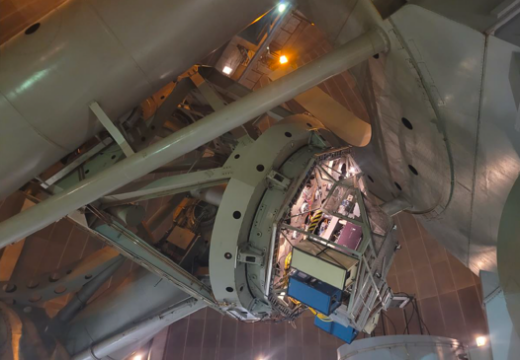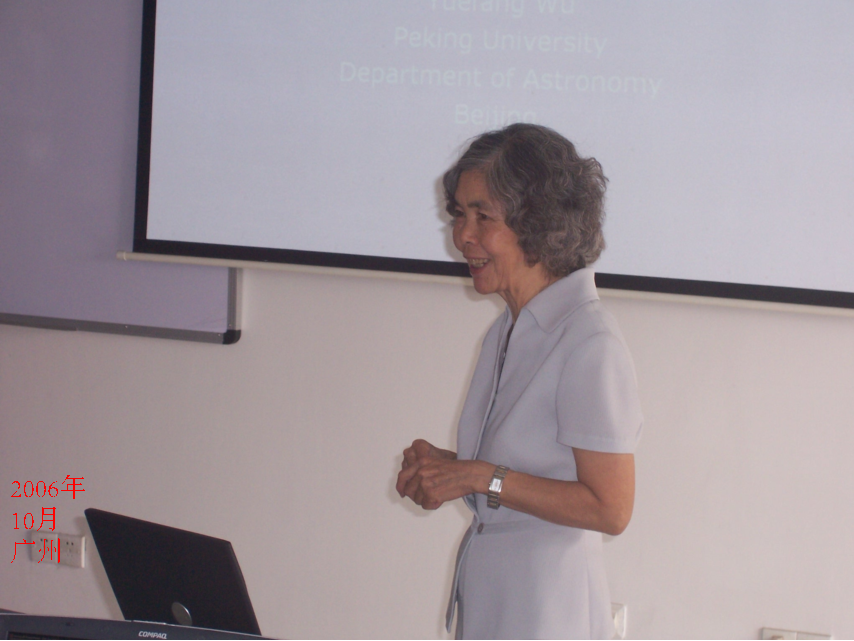 A research team led by Professor Liu Fukun from the Department of Astronomy at the School of Physics of Peking University and the Kavli Institute for Astronomy and Astrophysics recently discovered that the supermassive black hole at the center of our galaxy, Sgr A*, merged with an intermediate black hole about 10 million years ago. When stars get too close to a supermassive black hole, they can be thrown out at high speeds and become a hypervelocity star. By analyzing the velocity distribution of these hypervelocity stars in the Milky Way halo, the team found that between 50 and 250 million years ago, an intermediate-mass black hole of approximately 15,000 times the mass of the Sun existed near the supermassive black hole Sgr A* at the Galactic center. A research team led by Professor Liu Fukun from the Department of Astronomy at the School of Physics of Peking University and the Kavli Institute for Astronomy and Astrophysics recently discovered that the supermassive black hole at the center of our galaxy, Sgr A*, merged with an intermediate black hole about 10 million years ago. When stars get too close to a supermassive black hole, they can be thrown out at high speeds and become a hypervelocity star. By analyzing the velocity distribution of these hypervelocity stars in the Milky Way halo, the team found that between 50 and 250 million years ago, an intermediate-mass black hole of approximately 15,000 times the mass of the Sun existed near the supermassive black hole Sgr A* at the Galactic center.
|
 Recently, researchers from the University of Chinese Academy of Sciences, National Astronomical Observatories, Yunnan Observatories, Peking University, Beijing NormalUniversityproposed that searching for high-velocity stars ejected from globular clusters due to the gravitational slingshot effect (Hills mechanism) could provide compelling evidence for the long-sought intermediate-mass black holes (IMBHs). By conducting detailed orbital backtracking of nearly a thousand high-velocity stars identified in Gaia and LAMOST data, along with over a hundred globular clusters in the Milky Way, the research team discovered that the high-velocity star J0731+3717 was ejected from the globular cluster M15 approximately 20 million years ago at an extreme velocity of nearly 550 km/s, with a confidence level of 5.4σ. This exceptionally high ejection speed is most likely caused by the Hills mechanism, suggesting the possible presence of an intermediate-mass black hole at the center of M15. This study has been published as the cover article in the February 2025 issue of National Science Review (NSR), titled "A high-velocity star recently ejected by an intermediate-mass black hole in M15." Associate Professor Yang Huang from the University of Chinese Academy of Sciences is the co-first author and corresponding author of the paper. Dr. Qingzheng Li (a graduate student of Yunnan Astronomical Observatory) is also a co-first author. Researcher Jifeng Liu from the National Astronomical Observatories, Researcher Xiaobo Dong from Yunnan Astronomical Observatory, and Professor Huawei Zhang from Peking University are co-corresponding authors. Recently, researchers from the University of Chinese Academy of Sciences, National Astronomical Observatories, Yunnan Observatories, Peking University, Beijing NormalUniversityproposed that searching for high-velocity stars ejected from globular clusters due to the gravitational slingshot effect (Hills mechanism) could provide compelling evidence for the long-sought intermediate-mass black holes (IMBHs). By conducting detailed orbital backtracking of nearly a thousand high-velocity stars identified in Gaia and LAMOST data, along with over a hundred globular clusters in the Milky Way, the research team discovered that the high-velocity star J0731+3717 was ejected from the globular cluster M15 approximately 20 million years ago at an extreme velocity of nearly 550 km/s, with a confidence level of 5.4σ. This exceptionally high ejection speed is most likely caused by the Hills mechanism, suggesting the possible presence of an intermediate-mass black hole at the center of M15. This study has been published as the cover article in the February 2025 issue of National Science Review (NSR), titled "A high-velocity star recently ejected by an intermediate-mass black hole in M15." Associate Professor Yang Huang from the University of Chinese Academy of Sciences is the co-first author and corresponding author of the paper. Dr. Qingzheng Li (a graduate student of Yunnan Astronomical Observatory) is also a co-first author. Researcher Jifeng Liu from the National Astronomical Observatories, Researcher Xiaobo Dong from Yunnan Astronomical Observatory, and Professor Huawei Zhang from Peking University are co-corresponding authors.
|
 An international team of researchers led by PKU PhD student Qinyue Fei has found dark matter dominating the halos of two supermassive black holes in galaxies roughly 13 billion light years away, reports a new study published in The Astrophysical Journal on 5 February 2025. An international team of researchers led by PKU PhD student Qinyue Fei has found dark matter dominating the halos of two supermassive black holes in galaxies roughly 13 billion light years away, reports a new study published in The Astrophysical Journal on 5 February 2025.
|
 On November 8, 2024, astronomers at Caltech's Palomar Observatory directed a brand-new spectrograph instrument, the Next Generation Palomar Spectrograph (NGPS), to capture data from a newfound supernova. The resulting spectrum from the erupting star was a delight for the many team members in the USA and China, including at Peking University, who have been working on the instrument since 2017. The new first-light spectrum demonstrates new instrument's ability to capture more detail, and fainter targets, than its predecessor, the Double Spectrograph, which was installed on the historic Hale Telescope more than 40 years ago. On November 8, 2024, astronomers at Caltech's Palomar Observatory directed a brand-new spectrograph instrument, the Next Generation Palomar Spectrograph (NGPS), to capture data from a newfound supernova. The resulting spectrum from the erupting star was a delight for the many team members in the USA and China, including at Peking University, who have been working on the instrument since 2017. The new first-light spectrum demonstrates new instrument's ability to capture more detail, and fainter targets, than its predecessor, the Double Spectrograph, which was installed on the historic Hale Telescope more than 40 years ago.
|
 Prof. Wu Yuefang, an emeritus faculty of PKU astronomy, passed away peacefully on December 13 after a long illness. During her career, Prof. Wu made significant contributions to our understanding of star formation through her own research and through her students. In addition to her research, Prof. Wu was known as a dedicated advisor, mentor, and teacher for many students. Prof. Wu Yuefang, an emeritus faculty of PKU astronomy, passed away peacefully on December 13 after a long illness. During her career, Prof. Wu made significant contributions to our understanding of star formation through her own research and through her students. In addition to her research, Prof. Wu was known as a dedicated advisor, mentor, and teacher for many students.
|
 The spinning of Sagittarius A* is vital to characterize the supermassive black hole and it is crucial in testing the “cosmic censorship conjecture” and “no hair theorem” of black hole spacetime in Einstein's general relativity. Previous studies have shown that the spin of Sagittarius A* could be measured within 1 percent relative uncertainty by timing radio signals from pulsars. However, these measurements depend on the discovery of a pulsar in a very compact orbit of less than half a year, a challenging prospect from observation. In order to alleviate the problem, a recent study, carried out by Zexin Hu and Prof. Lijing Shao from KIAA, provides a novel method of combining the observation of two pulsars with larger orbital periods in the Galactic Center to precisely measure the spin of Sagittarius A*. The work has been published in the journal Physical Review Letters. The spinning of Sagittarius A* is vital to characterize the supermassive black hole and it is crucial in testing the “cosmic censorship conjecture” and “no hair theorem” of black hole spacetime in Einstein's general relativity. Previous studies have shown that the spin of Sagittarius A* could be measured within 1 percent relative uncertainty by timing radio signals from pulsars. However, these measurements depend on the discovery of a pulsar in a very compact orbit of less than half a year, a challenging prospect from observation. In order to alleviate the problem, a recent study, carried out by Zexin Hu and Prof. Lijing Shao from KIAA, provides a novel method of combining the observation of two pulsars with larger orbital periods in the Galactic Center to precisely measure the spin of Sagittarius A*. The work has been published in the journal Physical Review Letters.
|
 A research team led by Professor Liu Fukun from the Department of Astronomy at the School of Physics of Peking University and the Kavli Institute for Astronomy and Astrophysics recently discovered that the supermassive black hole at the center of our galaxy, Sgr A*, merged with an intermediate black hole about 10 million years ago. When stars get too close to a supermassive black hole, they can be thrown out at high speeds and become a hypervelocity star. By analyzing the velocity distribution of these hypervelocity stars in the Milky Way halo, the team found that between 50 and 250 million years ago, an intermediate-mass black hole of approximately 15,000 times the mass of the Sun existed near the supermassive black hole Sgr A* at the Galactic center.
A research team led by Professor Liu Fukun from the Department of Astronomy at the School of Physics of Peking University and the Kavli Institute for Astronomy and Astrophysics recently discovered that the supermassive black hole at the center of our galaxy, Sgr A*, merged with an intermediate black hole about 10 million years ago. When stars get too close to a supermassive black hole, they can be thrown out at high speeds and become a hypervelocity star. By analyzing the velocity distribution of these hypervelocity stars in the Milky Way halo, the team found that between 50 and 250 million years ago, an intermediate-mass black hole of approximately 15,000 times the mass of the Sun existed near the supermassive black hole Sgr A* at the Galactic center.
 Recently, researchers from the University of Chinese Academy of Sciences, National Astronomical Observatories, Yunnan Observatories, Peking University, Beijing NormalUniversityproposed that searching for high-velocity stars ejected from globular clusters due to the gravitational slingshot effect (Hills mechanism) could provide compelling evidence for the long-sought intermediate-mass black holes (IMBHs). By conducting detailed orbital backtracking of nearly a thousand high-velocity stars identified in Gaia and LAMOST data, along with over a hundred globular clusters in the Milky Way, the research team discovered that the high-velocity star J0731+3717 was ejected from the globular cluster M15 approximately 20 million years ago at an extreme velocity of nearly 550 km/s, with a confidence level of 5.4σ. This exceptionally high ejection speed is most likely caused by the Hills mechanism, suggesting the possible presence of an intermediate-mass black hole at the center of M15. This study has been published as the cover article in the February 2025 issue of National Science Review (NSR), titled "A high-velocity star recently ejected by an intermediate-mass black hole in M15." Associate Professor Yang Huang from the University of Chinese Academy of Sciences is the co-first author and corresponding author of the paper. Dr. Qingzheng Li (a graduate student of Yunnan Astronomical Observatory) is also a co-first author. Researcher Jifeng Liu from the National Astronomical Observatories, Researcher Xiaobo Dong from Yunnan Astronomical Observatory, and Professor Huawei Zhang from Peking University are co-corresponding authors.
Recently, researchers from the University of Chinese Academy of Sciences, National Astronomical Observatories, Yunnan Observatories, Peking University, Beijing NormalUniversityproposed that searching for high-velocity stars ejected from globular clusters due to the gravitational slingshot effect (Hills mechanism) could provide compelling evidence for the long-sought intermediate-mass black holes (IMBHs). By conducting detailed orbital backtracking of nearly a thousand high-velocity stars identified in Gaia and LAMOST data, along with over a hundred globular clusters in the Milky Way, the research team discovered that the high-velocity star J0731+3717 was ejected from the globular cluster M15 approximately 20 million years ago at an extreme velocity of nearly 550 km/s, with a confidence level of 5.4σ. This exceptionally high ejection speed is most likely caused by the Hills mechanism, suggesting the possible presence of an intermediate-mass black hole at the center of M15. This study has been published as the cover article in the February 2025 issue of National Science Review (NSR), titled "A high-velocity star recently ejected by an intermediate-mass black hole in M15." Associate Professor Yang Huang from the University of Chinese Academy of Sciences is the co-first author and corresponding author of the paper. Dr. Qingzheng Li (a graduate student of Yunnan Astronomical Observatory) is also a co-first author. Researcher Jifeng Liu from the National Astronomical Observatories, Researcher Xiaobo Dong from Yunnan Astronomical Observatory, and Professor Huawei Zhang from Peking University are co-corresponding authors.
 An international team of researchers led by PKU PhD student Qinyue Fei has found dark matter dominating the halos of two supermassive black holes in galaxies roughly 13 billion light years away, reports a new study published in The Astrophysical Journal on 5 February 2025.
An international team of researchers led by PKU PhD student Qinyue Fei has found dark matter dominating the halos of two supermassive black holes in galaxies roughly 13 billion light years away, reports a new study published in The Astrophysical Journal on 5 February 2025.
 On November 8, 2024, astronomers at Caltech's Palomar Observatory directed a brand-new spectrograph instrument, the Next Generation Palomar Spectrograph (NGPS), to capture data from a newfound supernova. The resulting spectrum from the erupting star was a delight for the many team members in the USA and China, including at Peking University, who have been working on the instrument since 2017. The new first-light spectrum demonstrates new instrument's ability to capture more detail, and fainter targets, than its predecessor, the Double Spectrograph, which was installed on the historic Hale Telescope more than 40 years ago.
On November 8, 2024, astronomers at Caltech's Palomar Observatory directed a brand-new spectrograph instrument, the Next Generation Palomar Spectrograph (NGPS), to capture data from a newfound supernova. The resulting spectrum from the erupting star was a delight for the many team members in the USA and China, including at Peking University, who have been working on the instrument since 2017. The new first-light spectrum demonstrates new instrument's ability to capture more detail, and fainter targets, than its predecessor, the Double Spectrograph, which was installed on the historic Hale Telescope more than 40 years ago.
 Prof. Wu Yuefang, an emeritus faculty of PKU astronomy, passed away peacefully on December 13 after a long illness. During her career, Prof. Wu made significant contributions to our understanding of star formation through her own research and through her students. In addition to her research, Prof. Wu was known as a dedicated advisor, mentor, and teacher for many students.
Prof. Wu Yuefang, an emeritus faculty of PKU astronomy, passed away peacefully on December 13 after a long illness. During her career, Prof. Wu made significant contributions to our understanding of star formation through her own research and through her students. In addition to her research, Prof. Wu was known as a dedicated advisor, mentor, and teacher for many students.
 The spinning of Sagittarius A* is vital to characterize the supermassive black hole and it is crucial in testing the “cosmic censorship conjecture” and “no hair theorem” of black hole spacetime in Einstein's general relativity. Previous studies have shown that the spin of Sagittarius A* could be measured within 1 percent relative uncertainty by timing radio signals from pulsars. However, these measurements depend on the discovery of a pulsar in a very compact orbit of less than half a year, a challenging prospect from observation. In order to alleviate the problem, a recent study, carried out by Zexin Hu and Prof. Lijing Shao from KIAA, provides a novel method of combining the observation of two pulsars with larger orbital periods in the Galactic Center to precisely measure the spin of Sagittarius A*. The work has been published in the journal Physical Review Letters.
The spinning of Sagittarius A* is vital to characterize the supermassive black hole and it is crucial in testing the “cosmic censorship conjecture” and “no hair theorem” of black hole spacetime in Einstein's general relativity. Previous studies have shown that the spin of Sagittarius A* could be measured within 1 percent relative uncertainty by timing radio signals from pulsars. However, these measurements depend on the discovery of a pulsar in a very compact orbit of less than half a year, a challenging prospect from observation. In order to alleviate the problem, a recent study, carried out by Zexin Hu and Prof. Lijing Shao from KIAA, provides a novel method of combining the observation of two pulsars with larger orbital periods in the Galactic Center to precisely measure the spin of Sagittarius A*. The work has been published in the journal Physical Review Letters.
